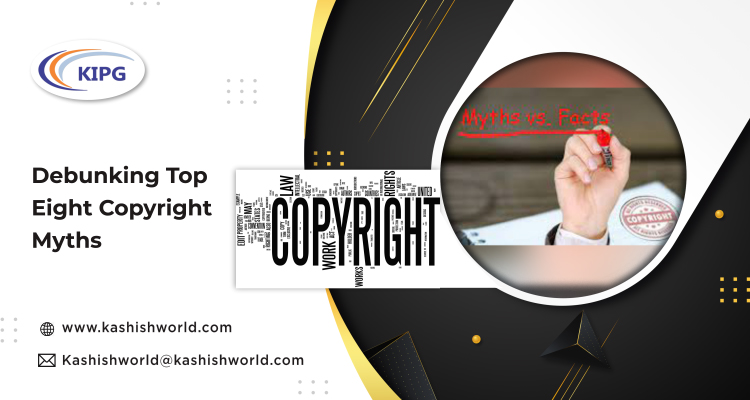
There have always been many inquiries concerning the number of common misunderstandings and misconceptions about Copyright Law. This article attempts to debunk the top eight copyright myths.
#Myth1 – Copyright Can Safeguard Your Ideas
Copyright Protection applies to recorded works; it doesn’t apply to something intangible such as an idea. Within some specific areas (like inventions), it may be possible to file a Patent Application. Since copyright protection applies to recorded works, such as artwork, music, documents, etc., if a competitor uses your copyrighted work (by copying, adapting, or stealing your creative work to promote their product or service), it would fall under Copyright Infringement. In such a scenario, you can undoubtedly take action against the infringer; however, it is essential to note that there is nothing much you can do to prevent an individual or entity from creating their work based on a similar idea as long as they are not copying or stealing your work to do so.
#Myth2 – Everything on the Internet Lies in the Public Domain and is Free to Use
It highlights the most common misconception about the term ‘public domain’ when used concerning copyrighted works. Creative works become a part of the public domain only after their copyright expires, which is generally many years after the owner’s or author’s death. Kindly note that creative works posted on the Internet may be publicly accessible, but they are certainly not in the public domain.
#Myth3 – Any Work Without a Copyright Notice isn’t Safeguarded
Copyright protection shall apply whether or not there is a copyright notice attached. In the United States, a copyright notice was needed to retain copyright protection on creative works published before 1st January 1978; however, it was the exception and not a standard and is certainly no longer the case. Besides, when the United States became a signatory to the Berne Convention for the Protection of Literary and Artistic Works, the copyright law in the nation was amended, and the use of a copyright notice on creative works published from 1st March 1989 became optional.
#Myth4 – You Can Copy 10% of a Creative Work Without Causing Copyright Infringement
Such is not the case. Any unauthorized use of copyrighted work can potentially lead to legal action from its owner or holder unless it is explicitly permitted under fair use or fair dealing rules.
When we talk about using extracts or quotes, there exists no percentage or magic figure that could be applied since every case must be viewed on its merit. What is clear from the cases that have come to trial is that it is the perceived importance of the copied content instead of simply the quantity that counts. What we advise is to always seek permission from the copyright holders before using their creative works.
#Myth5 – If You Change Someone Else’s Work, You Can Claim it as Your Own
Adapting or copying some individual’s or entity’s work is a restricted act. In legal terms, any adaptation is regarded as a derived work. Therefore, if you adapt the creative work of others, it shall still very much be their work, and they will own the right to object you from publishing such a work when they haven’t given you any permission to do so. Additionally, they are entitled to reclaim any money you make from selling their creative works.
The safest option in this aspect is to create something not copied or adapted from the creative work of others or seek permission from the copyright holder (for which you should expect to pay a fee or royalties). The creative works of others can undoubtedly inspire you; however, when it comes to your creative works, have a fresh start and don’t copy what others have already done.
#Myth6 – You Can Copyright a Title or Name
Copyright laws are indeed very restrictive; they don’t apply to titles and names that may be legitimately used in unrelated instances or duplicated coincidentally. There exists no reason from a copyright perspective why two creative works can’t have the same title. No infringement occurs as long as the content of the creative works isn’t adapted or copied. However, it doesn’t imply that there isn’t any protection on the name since it may be covered by other laws. If the name holds Trademark Protection or it could be proved that the title’s use confuses or misleads the general public (known as passing off), there can be issues. While copyright protection holds from the point a creative work comes into being, passing off is based on the general public perception of what the name means (i.e., one gets a clear idea of what to expect to be given if he asks for Coca-Cola).
#Myth7 – It’s Difficult to Prove Copyright Infringement
Such isn’t the case since copyright law is principally civil and not criminal. Civil law needs a lower burden of proof, thereby making it easier to prove copyright infringement. In a civil case, a plaintiff requires convincing the tribunal or court that his claim is valid and that it is likely that the defendant is guilty on the balance of probability. On the other hand, a defendant in a criminal case is innocent until, beyond any reasonable doubt, proven guilty.
#Myth8 – Confusion over Copyright Protection in the Music Industry
A sound recording has separate copyright protection from the underlying musical composition. It implies that a new sound recording of an old piece of music shall still very much be copyright protected even if the copyright protection in the original musical recording has expired.

